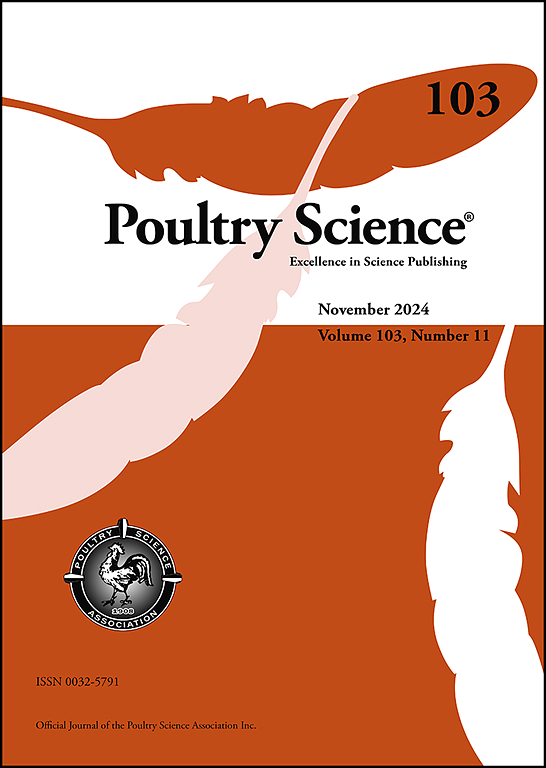Effects of energy density of diets and dietary Pediococcus acidilactici supplementation on productive performance, egg quality, and intestinal function in laying hens
IF 3.8
1区 农林科学
Q1 AGRICULTURE, DAIRY & ANIMAL SCIENCE
引用次数: 0
Abstract
The objective of this study was to evaluate the effects of supplementing Pediococcus acidilactici CNCM I-4622 MA 18/5 M (PA) into diets with two energy levels on the production performance and intestinal function of Lohmann pink laying hens from 49 to 65 weeks of age. A total of 1400 hens were used in this study. A 2 × 2 + 1 experimental design with 2 metabolic energy levels (2700.00 kcal/kg, NE; 2625.00 kcal/kg, LE), two PA levels (0 mg/kg, 110 mg/kg), and one group with intermittent PA supplementation (LE-0/PA). The experiment comprised 5 treatments with 14 replications each, and each replication had 20 hens. The results showed that reducing the dietary energy level tended to decrease body weight (P = 0.056). However, supplementing PA in low-energy diets tended to increase body weight in 16 weeks (P = 0.063). The LE-0/PA group had higher laying rates and feed utilization rates compared to other groups (P > 0.05), maybe resulting in greater economic benefits. The LE group had significantly lower eggshell strength, Haugh unit, trypsin activity, lipase activity, and tibia breaking strength compared to the NE group (P < 0.05). Dietary supplementation with PA significantly increased eggshell strength (P < 0.05), tibia breaking strength, villus height/crypt depth ratio (VH/CD), lipase activity, and secretory immunoglobulin A (SIgA) content in the jejunum (P < 0.05). Additionally, PA supplementation significantly reduced the expression of interleukin 8 (IL-8), tumor necrosis factor-α (TNF-α), toll-like receptor 4 (TLR-4), and nuclear factor kappa-B (NF-κB) mRNA (P < 0.05). In conclusion, reducing the dietary energy level of hens can reduce the body weight and feed utilization efficiency. However, dietary PA supplementation improved body weight, reduced the expression of intestinal inflammation-related factors, and enhanced intestinal health, particularly in low-energy diets. Intermittent PA supplementation may enhance performance benefits, suggesting its potential as a strategy to optimize production performance and intestinal health in hens.
饲粮能量密度和饲粮中添加酸活性球球菌对蛋鸡生产性能、蛋品质和肠道功能的影响
本试验旨在评价在2个能量水平饲粮中添加酸化Pediococcus CNCM I-4622 MA 18/5 M (PA)对49 ~ 65周龄罗曼粉蛋鸡生产性能和肠道功能的影响。试验共选用1400只蛋鸡。2 × 2 + 1试验设计,设2个代谢能水平(2700.00 kcal/kg, NE;2625.00 kcal/kg, LE)、两个PA水平(0 mg/kg、110 mg/kg)和一个间歇补充PA组(LE-0/PA)。试验分5个处理,每个处理14个重复,每个重复20只鸡。结果表明,降低饲粮能量水平有降低体重的趋势(P = 0.056)。然而,在低能量日粮中添加PA有增加16周体重的趋势(P = 0.063)。LE-0/PA组产蛋率和饲料利用率高于其他各组(P >;0.05),可能会产生更大的经济效益。与NE组相比,LE组蛋壳强度、哈夫单位、胰蛋白酶活性、脂肪酶活性和胫骨断裂强度显著降低(P <;0.05)。饲粮中添加PA可显著提高蛋壳强度(P <;0.05)、胫骨断裂强度、绒毛高度/隐窝深度比(VH/CD)、空肠脂肪酶活性和分泌性免疫球蛋白A (SIgA)含量(P <;0.05)。此外,PA补充显著降低了白细胞介素8 (IL-8)、肿瘤坏死因子-α (TNF-α)、toll样受体4 (TLR-4)和核因子κ b (NF-κB) mRNA的表达(P <;0.05)。综上所述,降低饲粮能量水平可降低蛋鸡体重和饲料利用效率。然而,膳食中添加PA可以改善体重,减少肠道炎症相关因子的表达,并增强肠道健康,特别是在低能量饮食中。间歇性添加PA可提高母鸡的生产性能,这表明它可能是优化母鸡生产性能和肠道健康的策略。
本文章由计算机程序翻译,如有差异,请以英文原文为准。
求助全文
约1分钟内获得全文
求助全文
来源期刊

Poultry Science
农林科学-奶制品与动物科学
CiteScore
7.60
自引率
15.90%
发文量
0
审稿时长
94 days
期刊介绍:
First self-published in 1921, Poultry Science is an internationally renowned monthly journal, known as the authoritative source for a broad range of poultry information and high-caliber research. The journal plays a pivotal role in the dissemination of preeminent poultry-related knowledge across all disciplines. As of January 2020, Poultry Science will become an Open Access journal with no subscription charges, meaning authors who publish here can make their research immediately, permanently, and freely accessible worldwide while retaining copyright to their work. Papers submitted for publication after October 1, 2019 will be published as Open Access papers.
An international journal, Poultry Science publishes original papers, research notes, symposium papers, and reviews of basic science as applied to poultry. This authoritative source of poultry information is consistently ranked by ISI Impact Factor as one of the top 10 agriculture, dairy and animal science journals to deliver high-caliber research. Currently it is the highest-ranked (by Impact Factor and Eigenfactor) journal dedicated to publishing poultry research. Subject areas include breeding, genetics, education, production, management, environment, health, behavior, welfare, immunology, molecular biology, metabolism, nutrition, physiology, reproduction, processing, and products.
 求助内容:
求助内容: 应助结果提醒方式:
应助结果提醒方式:


